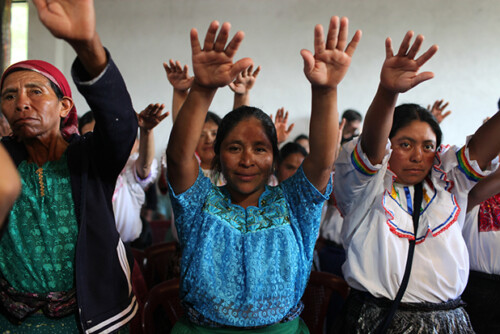Argentina: Materializing Kinship as Human Rights
Argentina and Guatemala are not often thought of together in anthropological scholarship. The politics of geography, culture, and race have tended to divide the continent into distinct ethnolinguistic regions, leading to a deep and nuanced understanding of the internal dynamics of Mesoamerica, the Caribbean, the Andean Region, and the Southern Cone, often at the expense of broad, comparative political analyses of Latin America. Even a cursory comparative analysis of Argentina’s experience of Cold War violence with that of Guatemala highlights the deep differences in scale, patterns of victimization, tactics of warfare, and transnational responses. However, by thinking these two cases together, the structuring transnational dimensions of both the practice of Cold-War violence and sociopolitical and technical responses to it are revealed.
Forensic genetics had its genesis in human rights work in Argentina in the early 1980s, with the development of the Index of Grandpaternity, a legally recognized genetic test capable of proving genetic relatedness between a grandparent and a child in the absence of the parental generation.1 Although genetic paternity testing was used in a small number of cases in the United States in the late 1970s, it remained a nascent technology surrounded by doubt about its reliability and validity.2 What we now think of as “DNA fingerprinting”3 emerged a year after the development of the Index of Grandpaternity in Argentina, inaugurating the biogenetic turn, which continues to dominate criminalistics and public portrayals of criminal justice. Argentina can therefore serve as an alternative origin story for the configuration of the relationship between genetic analyses of the body and political order, one rooted in a politics of human rights and women’s activism.
As scholars familiar with repressive regimes—in places as diverse as Mussolini’s Italy and contemporary China—it is common to see families and family changes as the building blocks of reform. Moreover theorists of nationalism like Mosse, Anderson, and Parker have emphasized the strong relationship between the nation-state and the particular gendered and sexed constructions of the citizen and family.4 In Argentina, the war against subversion was waged at the level of the family, not the family as biogenetic lineage, but rather the family as social-political entity—the family as model and mode of the nation in formation.
Survivors and searching family members describe the government and the organized Left as both adopting a pronatalist policies, encouraging their members to have children even as disappearances were going on. A common joke among friends who were born in this period or shortly before was to count the women in the room named Victoria—laughing about how, regardless of their parents’ political ideologies, they all imagined their victory in the bodies of their children.5 The repressive forces, in turn, also focused their work of disappearances and torture directly on the family: children and spouses were brutally tortured in front of one another, following an explicit manual of psychological and physical torture designed to not only break apart the family, but to strip prisoners of their sense of belonging to a collective humanity.6 Jacobo Timmerman, in Prisoner Without a Name, Cell Without a Number, his memoir of surviving Argentina’s clandestine detention centers, describes one such scene of torture:
The entire affective world, constructed over a lifetime with utmost difficulty, collapses with a kick in the father’s genitals, a smack of the mother’s face, and obscene insult to the sister, or the sexual violation of a daughter. Suddenly an entire culture based on familial love, devotion, and the capacity for mutual sacrifice collapses. Nothing is possible in such a universe, and that is precisely what the torturers know.7
Not only was the family central to torture, but also to the ideological reorganization of Argentina. The genocidal logic of Argentina’s military junta was unique in that the family, rather than a naturalized blood or racialized identity, was constructed as the primary means of political transmission. This focus on the family was central to court rulings declaring that the disappearances in Argentina fit international definitions of genocide, thereby expanding existing legal frameworks to include the explicit destruction of political groups as a form of genocide.8 Searching mothers and grandmothers often spoke of the bureaucratic dismissal of their political rights and writs of habeas corpus through a rhetoric of gendered condemnation. As Irma described, “they would look at us with contempt and menace saying: go home and take better care in raising the rest of your children. If you spent less time on the street and more time doing your motherly duty, your daughter would not be in this trouble.”
The primary forms of human rights resistance that emerged were similarly constructed in familial terms. Argentina is paradigmatic in its family-based organizing. Not only are there the Mothers of the Plaza de Mayo, but also the Grandmothers, the HIJOS, the Hermanos, and the Nietos. In contemporary Argentina, the family as a form of identity politics has become the grounds of social movements for human rights, and status as an injured family is central to making claims on the Argentine state for justice. Part of the power of this form of resistance is the seeming naturalness of this kind of claims-making, locating democratic transition in realm of the reproductive.
Although the Mothers of the Plaza de Mayo have become the international symbol for the family movement, an equally important organization in Argentina is the Abuelas of the Plaza de Mayo. The group represents families who suffered a double loss—the loss of an adult child concomitantly with a grandchild, either because the baby was taken with the mother or was born in captivity. They have chosen to organize with the explicit goal of identifying and being reunited with their grandchildren, rather than primarily with their children. With the return to democracy, and the slow societal realization that the “disappeared” were unlikely to return alive, the Abuelas turned their focus to their grandchildren, as more and more reports surfaced that the military had systematically kidnapped these small babies and given them to military families to “raise up right.”
In their original statement of purpose, written during the dictatorship in 1982, the Abuelas made a series of demands:
Regarding our grandchildren, we ask that the fate handed to each and every one of the disappeared children in the Argentine Republic since 1975 be clarified, as well as the fate of the babies born in detention camps where their young mothers were taken while pregnant, and that these children be integrated with their family members, and all their rights respected: right to life, right to maintain their true identity, right to live with their legitimate family.9
Before the advent of a genetic test for grandpaternity, the Abuelas demanded knowledge from the state paired with a reminder of what they saw as fundamental rights: life, identity, and family. The Abuelas received no official response from the state for their demands to know the location of each of their missing grandchildren. They were most often told to stop looking or that the babies were dead, killed in utero along with their subversive mothers.
The Abuelas have spent the last 30 years proving that this appropriation of children during the dictatorship was a systematic plan by the government to rupture natal families. In a groundbreaking book, War Spoils,10 they compare the kidnapping of children to the kind of looting that took place in disappeared people’s homes. Like a television or a nice piece of furniture, children became one more piece of booty used to reward the foot soldiers of the right. This particular narration of these children as consumer objects, a kind of human trafficking, fit well with the grandmothers’ claims to the children, and their argument that these children should be returned to them. As I discuss later in this paper, when we turn to the experiences of these kidnapped youth, the reality of the dictatorship’s systematic appropriation was, in many ways, more sinister and effective than human trafficking. The government not only broke apart families, but also built new ones with all the concomitant realities of duty, love, and socialization.
Through their investigations the Abuelas found children they believed to be their disappeared grandchildren. However, they faced serious difficulties in making legal claims to these children in the Argentine courts. As one grandmother told me, in those days they didn’t know how to prove they were the grandmothers, they just knew it to be true through their investigations. The Abuelas appealed to the state, claiming an epistemology of maternal love and recognition. As Nelida Navajos described in the early days of searching:
Later other grandmothers decided to go visit [suspected houses] with advertisements for baby products from some laboratory, ring the doorbell, recommend the product, and ask ‘is there a baby in the house?’ That is how they came to certain conclusions. When we saw them we knew that these poor creatures were, in their own way, prisoners, because they were afraid and were not allowed to play with other children […] Some of these grandmothers began to say, “that child is just like my daughter. She walks the same way. She has this. She has that.” But we couldn’t go to a judge and say, ‘we think this child is [stolen] because he looks just like when my child was young.’
Although rhetorically powerful and emotionally meaningful, this type of evidence did not hold forensic sway in Argentine courts.
The Abuelas searched for a credible technology that could provide incontrovertible proof of a child’s origin. Eyewitness testimony of live births and appropriations, interviews with neighbors, and documentary analysis of allegedly falsified birth certificates were not accepted by the court as sufficient proof of relatedness. How did they know this child was related to this grandmother? What seems routine today, genetic tests for relatedness between a grandparent and child in the absence of the parental generation, took a heroic effort to establish in the early 1980s. The Abuelas traveled to more than twelve countries in Europe and the Americas, begging scientists to help them with their attempt to prove relatedness. It took an international team of mathematicians and scientists to successfully identify the first grandchild. Not only was this a scientific process, but it was coproduced with a legal apparatus that recognized the authoritativeness of this claim. In 1984, the Abuelas regained custody of the first child via this method, Paula Logares, placing genetic tests for identity at the center of Argentine attempts to reconcile the crimes of the past. In the decades since that first case, the Abuelas and the democratic Argentine state have relied on blood testing, first using HLA analysis and later forensic genetics to arbitrate identity. Indeed, the rights outlined by the grandmothers in their original statement, the right to life, the right to “true” identity, and the right to live with one’s legitimate family, have become enshrined in international law through the International Convention on the Rights of the Child, and through myriad cultural and social practices that rely on DNA to determine ultimate paternity, identify and reunite with birth parents, and even identify and connect with sperm donors.
The historical emergence of this kind of identificatory genetics in Argentina shows how a focus on kinship created a very specific kind of faith in the reconstruction of the biological family as political reconstitution. Given the form of political violence with its focus on families, this genetic reification of biological kinship tied DNA analysis to the furthering of the project of democratic legitimacy. We can see this linkage in a speech by Juliana, whose younger brother was disappeared by the dictatorship and is thought to be one of the 500 young adults in Argentina who live with falsified names and identities: “We will never have democracy until each one of these missing children knows who he or she is. Because even now there are those who still live beneath the boots of the dictatorship.”
The kind of political and legal work that DNA as the Index of Grandpaternity was capable of doing is important to understand. It was a particular kind of identification that linked the unidentified not as themselves as the same across time in place, but as a member of a particular biogenetic grouping—DNA, as it was deployed in human rights, explicitly did the work of kinship. An important difference in the focus of identification in Argentina is its consolidation around the living, rather than the dead. Living Abuelas seeking justice were connected through the analysis of their blood to their living grandchildren whose present-day (but fraught and complicated) kinship to both dictatorship-aligned families, and prospectively to the Abuelas themselves, the very victims of that dictatorship, represented a victory of sorts for democracy.
Returning, then, to contemporary practices of forensic genetic identification in Guatemala, it is only through the material construction of DNA technology in the early post-dictatorship period in Argentina that the packaged nexus of forensic DNA science as a tool for justice on behalf of the disappeared in Guatemala takes shape. The Index of Grandpaternity provides identity—but a very specific kind; not identity in the sense of being one and the same (i.e., identical) but identity in genealogical terms. In traditional forensic DNA, the DNA “fingerprint” genetic markers are used to show that the sample from the crime scene matches a known person—they are the “same” person, even though removed in time and space. In the Index of Grandpaternity, which has, in the last 30 years become a field of forensic genetics, kinship analysis motivates the taking of a sample from an unidentified body or child, and matches that to a reported missing person within a genealogical family tree. The surviving family is used to virtually reconstruct the disappeared person. Using statistics, the missing person’s likely genetic markers are calculated, hailing them into the present. Pursuing the same kind of hopeful return as witnessed in Argentina, forensic scientists in Guatemala enroll the databank to materialize the disappeared person, allowing for the missing child or body to be rightfully placed back within the family. But as emphasized above, the distinction here is that the missing child in the Guatemalan case is presumed dead, as distinct from perpetually missing, but understood to be alive and living a misidentified life. As I suggest below, that distinction has made forensic DNA analysis in Guatemala into an apparatus of a melancholic naturalization of an idealized biological kinship.
- A. Di Lonardo, P. Darlu, M. Baur, C. Orrego, and M. King, “Human Genetics and Human Rights: Identifying the Families of Kidnapped Children,” American Journal of Forensic Medicine & Pathology 5.4 (1984): 339–47. [↩]
- Ira Mark Ellman and David H. Kaye, “Probabilities and Proof: Can HLA and Blood Group Testing Prove Paternity?” New York University Law Review 54 (1979); Leonard R. Jaffee, “Comment on the Judicial Use of HLA Paternity Test Results and Other Statistical Evidence: A Response to Terasaki,” Journal of Family Law 17 (1978): 457; David H. Kaye, “Probability of an Ultimate Issue: The Strange Cases of Paternity Testing,” Iowa Law Review 75 (1989). [↩]
- A. J. Jeffreys, V. Wilson, and S. L. Thein, “Individual-specific ‘fingerprints’ of Human DNA,” Nature 316.6023 (1985): 76–79. [↩]
- G.L. Mosse, Nationalism and Sexuality: Middle-class Morality and Sexual Norms in Modern Europe, (Madison: U of Wisconsin P, 1988); B.R. Anderson, Imagined Communities: Reflections on the Origin and Spread of Nationalism, (London: Verso, 1991); Andrew Parker, Nationalisms & Sexualities, (New York: Routledge, 1992). [↩]
- Cf. Laura Alcoba, La Casa de Los Conejos, (Edhasa: 2008). [↩]
- CONADEP, Nunca Más: Informe de La Comisión Nacional Sobre La Desaparición de Personas, (Buenos Aires: EUDEBA, 2003); M. Feitlowitz, A Lexicon of Terror: Argentina and the Legacies of Torture, (New York: Oxford UP, 1998). [↩]
- Jacobo Timerman, Prisoner Without a Name, Cell Without a Number, (New York: Knopf, 1981): 148. [↩]
- Klein 2008. [↩]
- R. Arditti, Searching for Life: The Grandmothers of the Plaza de Mayo and the Disappeared Children of Argentina, (Berkeley: U of California P, 1999): 187–8. [↩]
- Julio E. Nosiglia, Botín de Guerra, (Cooperativa Tierra Fértil, 1985). [↩]




